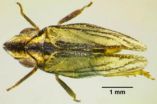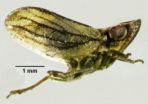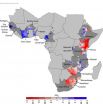(Press-News.org) Not much is known about the the genus of planthopper known as Conosimus, which now includes six species after a new one was recently discovered in the southern part of the Iberian Peninsula in the Spanish city of Jaen. A description of it appears in the open-access Journal of Insect Science (see http://www.insectscience.org/14.92/).
The new species, Conosimus baenai, has been named after Manuel Baena, a Spanish hemipterologist, for his contributions to the taxonomy of Iberian Hemiptera.
Conosimus baenai differs in appearance from the other species in the Conosimus genus due to the coloration of its forewings and veins. All of the other species have veins that are the same color as their wings, which are usually light brown or light-brown yellowish. However, Conosimus baenai has light yellow or greenish-yellow wings with radial and median veins that are framed by dark brown or black stripes.
The new species was found in a medium-high mountain area that is dominated by thorny shrubs called Echinospartum boissieri, of which it seems to be associated. This rare shrub, which is endemic to the Baetic Range in southern Spain, blooms and produces fruit from July to August.
The other five species in the genus are C. coelatus, C. malfanus, C. violantis, C. noualhieri, and C. horvathi.
INFORMATION:
The full open-access article is available at http://www.insectscience.org/14.92/.
The Journal of Insect Science is published by the Entomological Society of America, the largest organization in the world serving the professional and scientific needs of entomologists and people in related disciplines. Founded in 1889, ESA today has nearly 7,000 members affiliated with educational institutions, health agencies, private industry, and government. Members are researchers, teachers, extension service personnel, administrators, marketing representatives, research technicians, consultants, students, and hobbyists. For more information, visit http://www.entsoc.org.
New planthopper species found in southern Spain
2014-07-22
ELSE PRESS RELEASES FROM THIS DATE:
Middle East Respiratory Syndrome coronavirus detected in the air of a Saudi Arabian camel barn
2014-07-22
Saudi Arabian researchers have detected genetic fragments of Middle East Respiratory Syndrome coronavirus (MERS-CoV) in the air of a barn holding a camel infected with the virus. The work, published this week in mBio®, the online open-access journal of the American Society for Microbiology, indicates that further studies are needed to see if the disease can be transmitted through the air.
MERS, a serious viral respiratory illness caused by the coronavirus, has been identified in 699 people as of June 11, according to the World Health Organization; 209 people have died ...
Viral therapy could boost limb-saving cancer treatment
2014-07-22
Viruses designed to target and kill cancer cells could boost the effectiveness of chemotherapy to the arms and legs and help avoid amputation, a new study reports.
Scientists at The Institute of Cancer Research, London, tested the effectiveness of a genetically engineered version of the virus used to vaccinate against smallpox.
They found use of the virus alongside isolated limb perfusion chemotherapy – given directly to blood vessels supplying the affected arm or leg as an alternative to amputation – was more effective in rats than either treatment on its own.
The ...
New study finds high school lacrosse players at risk for concussions, other injuries
2014-07-22
Lacrosse is one of the fastest-growing high school sports in the United States, with more than 170,000 students now playing the sometimes hard-hitting game. The growing participation numbers, however, mean that more young people than ever are at risk of injury in lacrosse practice and competition.
In a study published online today by The American Journal of Sports Medicine and available in an upcoming print issue, researchers from the Center for Injury Research and Policy at Nationwide Children's Hospital and the Colorado School of Public Health found that high school ...
Schizophrenia's genetic 'skyline' rising
2014-07-22
The largest genomic dragnet of any psychiatric disorder to date has unmasked 108 chromosomal sites harboring inherited variations in the genetic code linked to schizophrenia, 83 of which had not been previously reported. By contrast, the "skyline" of such suspect variants associated with the disorder contained only 5 significant peaks in 2011. By combining data from all available schizophrenia genetic samples, researchers supported by the National Institutes of Health powered the search for clues to the molecular basis of the disorder to a new level.
"While the suspect ...
Largest gene discovery 'kick-starts' new search for schizophrenia treatments
2014-07-22
VIDEO:
Largest gene discovery helps 'kick-start' new search for schizophrenia treatments - The discovery of over a hundred genetic risk factors linked to schizophrenia provides vital new clues in understanding what...
Click here for more information.
The discovery of over a hundred genetic risk factors linked to schizophrenia provides vital new clues in understanding what causes the condition and will kick-start the search for new treatments, according to leading UK scientists. ...
International team sheds new light on biology underlying schizophrenia
2014-07-22
July 21, 2014 (Toronto) – As part of a multinational, collaborative effort, researchers from Canada's Centre for Addiction and Mental Health (CAMH) have helped identify over 100 locations in the human genome associated with the risk of developing schizophrenia, in what is the largest genomic study published on any psychiatric disorder to date. The findings, published online in Nature, point to biological mechanisms and pathways that may underlie schizophrenia, and could lead to new approaches to treating the disorder, which has seen little innovation in drug development ...
LSU's Mark Batzer contributes to Nature Genetics article on marmoset genome
2014-07-21
BATON ROUGE – LSU's Mark Batzer, Boyd Professor and Dr. Mary Lou Applewhite Distinguished Professor in Department of Biological Sciences in the College of Science, contributed to an article in the scientific journal Nature Genetics, titled "The Common Marmoset Genome Provides Insight into Primate Biology and Evolution," published on July 20.
Batzer contributed analysis of "jumping genes," or mobile elements that move by a sort of "copy and paste" mechanism in the genome. The marmoset is important because it is the first "New World" monkey genome to be sequenced.
An ...
Temple study compares deep vein thrombosis therapies
2014-07-21
(Philadelphia, PA) – Patients who have a clot in their legs and are considering whether to be treated with traditional blood-thinning medication or undergo a minimally-invasive catheter-based clot removal procedure should feel comfortable that there is no difference in death rates between the two treatments, although there are more bleeding risks with the catheter procedure, according to a study by Temple University School of Medicine researchers. The study involved a review of more than 90,000 cases nationwide.
Riyaz Bashir, MD, a specialist in interventional cardiology ...
'Moral victories' might spare you from losing again
2014-07-21
It's human nature to hate losing.
Unfortunately, it's also human nature to overreact to a loss, potentially abandoning a solid strategy and thus increasing your chances of losing the next time around.
That's one conclusion of a Brigham Young University study published this week by the journal Management Science. The finding is based on an analysis of two decades of data on NBA coaching decisions.
The researchers focused on whether coaches adjusted their personnel following games where the margin of victory or defeat was small. After narrow wins, coaches changed their ...
Water, water -- not everywhere: Mapping water trends for African maize
2014-07-21
Today's food production relies heavily on irrigation, but across sub-Saharan Africa only 4 percent of cultivated land is irrigated, compared with a global average of 18 percent. Small-scale farming is the main livelihood for many people in the region, who depend on rainfall to water their crops.
To understand how climate change may affect the availability of water for agriculture, researchers at Princeton University analyzed trends in the water cycle in maize-growing areas of 21 African countries between 1979 and 2010. The team examined both levels of rainfall and the ...




